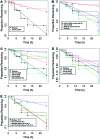Regulation of Caenorhabditis elegans male mate searching behavior by the nuclear receptor DAF-12
- PMID: 18854588
- PMCID: PMC2600945
- DOI: 10.1534/genetics.108.093773
Regulation of Caenorhabditis elegans male mate searching behavior by the nuclear receptor DAF-12
Abstract
Coordination of animal behavior with reproductive status is often achieved through elaboration of hormones by the gonad. In the nematode Caenorhabditis elegans, adult males explore their environment to locate mates. Mate searching is regulated by presence of mates, nutritional status, and a signal from the gonad. Here we show that the gonadal signal acts via the nuclear receptor DAF-12, a protein known to regulate several C. elegans life-history traits. DAF-12 has both activational and organizational functions to stimulate exploratory behavior and acts downstream of the gonadal signal, outside of the gonad. DAF-12 acts upstream of sensory input from mating partners and physiological signals indicating nutritional status. Mate searching was rescued in germ-line ablated animals, but not if both germ line and somatic gonad were ablated, by a precursor of the DAF-12 ligand, dafachronic acid (DA). The results are interpreted to suggest that the germ line produces a DA precursor that is converted to DA outside of the germ line, possibly in the somatic gonad. As it does in other pathways in which it functions, in regulation of male mate searching behavior DAF-12 acts at a choice point between alternatives favoring reproduction (mate searching) vs. survival (remaining on food).
Figures




Similar articles
-
The somatic reproductive tissues of C. elegans promote longevity through steroid hormone signaling.PLoS Biol. 2010 Aug 31;8(8):e1000468. doi: 10.1371/journal.pbio.1000468. PLoS Biol. 2010. PMID: 20824162 Free PMC article.
-
Distinct activities of the germline and somatic reproductive tissues in the regulation of Caenorhabditis elegans' longevity.Genetics. 2008 Jan;178(1):513-26. doi: 10.1534/genetics.107.083253. Genetics. 2008. PMID: 18202391 Free PMC article.
-
A bile acid-like steroid modulates Caenorhabditis elegans lifespan through nuclear receptor signaling.Proc Natl Acad Sci U S A. 2007 Mar 20;104(12):5014-9. doi: 10.1073/pnas.0700847104. Epub 2007 Mar 14. Proc Natl Acad Sci U S A. 2007. PMID: 17360327 Free PMC article.
-
Exploratory decisions of the Caenorhabditis elegans male: a conflict of two drives.Semin Cell Dev Biol. 2014 Sep;33:10-7. doi: 10.1016/j.semcdb.2014.06.003. Epub 2014 Jun 23. Semin Cell Dev Biol. 2014. PMID: 24970102 Review.
-
Neural Circuitry That Mediates Behavior Governing the Tradeoffs Between Survival and Reproduction in Caenorhabditis elegans.Integr Comp Biol. 2017 Dec 1;57(6):1161-1165. doi: 10.1093/icb/icx077. Integr Comp Biol. 2017. PMID: 28992344 Free PMC article. Review.
Cited by
-
Incomplete proline catabolism drives premature sperm aging.Aging Cell. 2021 Feb;20(2):e13308. doi: 10.1111/acel.13308. Epub 2021 Jan 21. Aging Cell. 2021. PMID: 33480139 Free PMC article.
-
Sex differences in behavioral decision-making and the modulation of shared neural circuits.Biol Sex Differ. 2012 Mar 21;3:8. doi: 10.1186/2042-6410-3-8. Biol Sex Differ. 2012. PMID: 22436578 Free PMC article.
-
Cytochromes P450 of Caenorhabditis elegans: Implication in Biological Functions and Metabolism of Xenobiotics.Biomolecules. 2022 Feb 22;12(3):342. doi: 10.3390/biom12030342. Biomolecules. 2022. PMID: 35327534 Free PMC article. Review.
-
Sexual Dimorphism and Sex Differences in Caenorhabditis elegans Neuronal Development and Behavior.Genetics. 2018 Mar;208(3):909-935. doi: 10.1534/genetics.117.300294. Genetics. 2018. PMID: 29487147 Free PMC article.
-
PDF-1 neuropeptide signaling modulates a neural circuit for mate-searching behavior in C. elegans.Nat Neurosci. 2012 Dec;15(12):1675-82. doi: 10.1038/nn.3253. Epub 2012 Nov 11. Nat Neurosci. 2012. PMID: 23143519 Free PMC article.
References
-
- Alcedo, J., and C. Kenyon, 2004. Regulation of C. elegans longevity by specific gustatory and olfactory neurons. Neuron 41 45–55. - PubMed
-
- Antebi, A., 2006. Nuclear hormone receptors in C. elegans, in WormBook, edited by The C. elegans Research Community. WormBook, http://www.wormbook.org. - PMC - PubMed
-
- Antebi, A., J. G. Culotti and E. M. Hedgecock, 1998. daf-12 regulates developmental age and the dauer alternative in Caenorhabditis elegans. Development 125 1191–1205. - PubMed
-
- Bargmann, C. I., and H. R. Horvitz, 1991. Chemosensory neurons with overlapping functions direct chemotaxis to multiple chemicals in C. elegans. Neuron 7 729–742. - PubMed
Publication types
MeSH terms
Substances
LinkOut - more resources
Full Text Sources
Molecular Biology Databases
Research Materials
Miscellaneous

